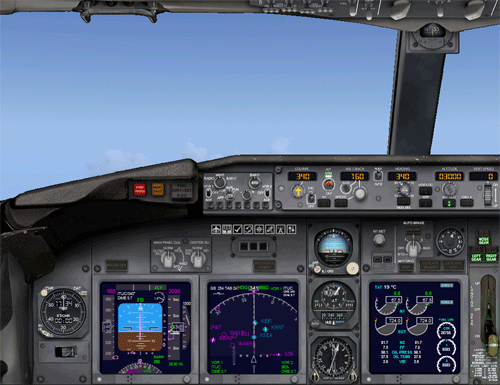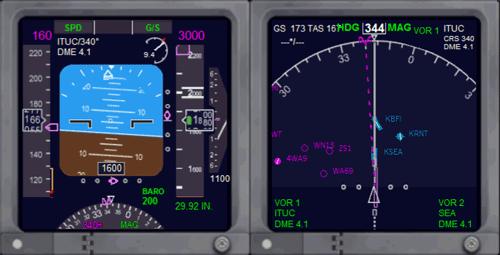
Lesson 3: The full ILS approach
Years ago a flight instructor was asked what the letters "ATP" meant. He replied, "Always Totally Proficient." Well, it doesn't quite mean that, but the definition is close enough for our purposes. After this lesson you will be "almost" totally proficient in flying ILS approaches in the Boeing 737.
This lesson will cover the details of making an ILS approach in the Boeing 737. In it, you'll have a chance to apply all that you've learned on the two previous ATP lessons. So let's begin at the beginning of the approach.
Approach Self-Briefing
Now that we know the local airport conditions, the local altimeter setting, and the expected active runway for arrival, we can begin to get organized for the approach. This is especially relevant since a major organ--your brain--is involved in this process. Now is the time to review the approach chart for the approach you'll fly. If you haven't done so already, this is an excellent time to use the autopilot to fly the plane while you focus your attention on the approach information. (You can read my brief article, Autopilot Fundamentals, or you can learn a lot more about it in the Learning Center article, Using the Autopilot.)
- The pre-approach briefing should take place prior to reaching the initial approach fix. Make sure you have the correct chart for the airport, runway and approach used.
The key elements to briefing include the following:
- The airport elevation.
- The primary navigation aid and its frequency.
- The direction of the inbound course.
- The altitude at which the glide slope is intercepted.
- The name of the final approach fix.
- The minimum descent point (such as altitude, DME, or time, depending on the type of approach).
- The missed approach procedure.
- Any specific visibility requirements (such as 1 mile or 5,000 feet).
You most likely will not be tuning the radios and setting inbound courses at this point. This will be done when it is time for the Approach checklist. We still need to follow a standard arrival procedure or follow ATC's instructions as they vector us down from cruise altitude.
The Approach
We've already covered the basics of descent planning and speed control and now it's time to transition into the airport environment and land. As a Flight Simulator pilot equipped with the appropriate approach plates for the airport and runway, there is often a coverage gap in the charts between the end of an arrival and the entry to the charted approach procedure for the runway of choice. If you are flying using the ATC features in Flight Simulator, you will be radar "vectored" (given specific headings to fly) onto the final approach course. If you are flying without ATC, you will need to plan to be at a certain altitude, speed, and heading in order to successfully intercept the final approach course properly configured.
Approach and Landing Tips
|
 Figure 3-1 |
A rough rule of thumb for this approach transition area is to plan to be 3,000 feet AGL at 10 nautical miles (nm) from the airport, while properly configured and established on the localizer. Approaching this 10 nm point you want to be slowed to no more than 170 knots with flaps set to 5. (Shown in Figure 3-1) As the glide slope "comes alive" (starts moving away from a full deflection) you will want to extend the gear, increase flaps to 15, and slow to 160 knots. At 3,000 AGL and 10 nm out, you should be close to intercepting, if not on, the glide slope.
Keep in mind that these are approximate altitudes and distances to place you close to a 3 degree descent path for final approach. Each approach is different to allow for items such as terrain or ground obstructions. At the final approach fix (FAF) set flaps 30 for landing, set power between 53 percent and 55 percent N1, and fly the glide slope down to a smooth landing.
Whether you are being vectored by ATC or have followed your own descent path, the key to a successful approach and landing is being prepared. This means you have the right chart out for the approach (as you have already done during your descent checklist right?) and have tuned the radios to the correct frequencies and set the inbound course. Briefing yourself on the approach procedure and key altitudes is important, as is having the proper mental image of the procedure so that you can stay ahead of the approach.
The Approach and Landing
 Figure 3-2 |
Once you're established on the localizer with the glide slope indicator "alive," configured with the gear down, flaps set to 15, and slowing to your target speed of 150 knots (or the appropriate Vref speed for your weight, if you are going to that level of detail), you are ready to intercept the glide slope and fly it on down to the runway. At the point of glide slope intercept from below where you're still "one dot low" (as shown in Figure 3-2) with the glide slope needle moving downward, set the final landing flaps to 30 and set your power to about 53 percent N1. Begin your pitch down to 0 degrees and monitor your position left or right relative to the localizer and high or low relative to the glide slope.
Tracking an ILS
The best way to fly an ILS approach with the needles centered is to be properly configured, trimmed, and on speed at the final approach fix. To correct flight path deviations, make frequent, small corrections when tracking the localizer and glide slope. Waiting too long to fix a deviation will send you into "pilot induced oscillation" getting you farther behind the process. It could also result in knocking down a few trees by not remaining on glide slope.
Tracking the Glide Slope
If you are above the glide slope with the pitch set correctly at 0 degrees, then reduce your pitch to recapture the glide slope while simultaneously reducing power by 1 percent to 2 percent N1 to keep your airspeed from increasing. If you are below the glide slope with the pitch set correctly at 0 degrees, then increase your pitch slightly to recapture the glide slope while simultaneously adding power (1 to 2 percent N1) to keep your airspeed from decreasing. The secret to recapturing a wayward glide slope needle is to make pitch and power changes simultaneously. This helps you maintain the desired airspeed during the recapture. If you're on glide slope and your airspeed is either too high or too low, then make a 1 to 2 percent N1 power adjustment while moving your elevator to maintain the desired pitch. If your pitch is not stabilized, you will have a difficult time capturing and staying on the glide slope. If you maintain the configuration, pitch, and power settings provided, use small power adjustments to maintain the glide slope.
Tracking the Localizer
If you are left of the localizer course but on heading: turn right 2 degrees, level the wings and be patient. As you recapture the localizer, turn back to your inbound course. Use the opposite technique if you are to the right of course. If you are 2 dots or more off centerline, turn to a heading up to 5 degrees off the inbound course, and level the wings. Use the width of the heading bug to limit the degrees of correction to use. It's wise to avoid banking more than half of a standard rate turn when making course corrections on an ILS. Again, make small changes and have patience.
You can also get a lot of help learning to fly an ILS from the Flight Director mode on the autopilot. I'll let you read about that on your own.
The Instrument Scan
Making small, frequent corrections means you will need to scan your instruments rapidly, as you learned in the instrument rating lessons. The technique for scanning instruments in the Boeing 737 is a little different than the Cessna Skyhawk, but your earlier training should help a lot here.
The primary instrument to use as the center point is the artificial horizon, or the attitude direction indicator (ADI) in this aircraft. The goal is to start at the ADI, reference the other key instruments one at a time, returning to the ADI. HSI refers to the Horizontal Situation Indicator; VSI refers to the Vertical Speed Indicator.
Instrument Scan
One scan pattern that works well for the Boeing 737 is the following: ADI, VSI, ADI (1, 2, 1) |
Try not to fixate on any one instrument. Take a mental snap shot of the instrument as you return your scan to the ADI. Apply required corrections as you scan other instruments: this is the fun part. Skip instruments you do not need to scan. If your airspeed is where you want it and stabilized, you can skip the N1 percent check in that round.
As you near the approach end of the runway, the localizer and glide slope needles will be more sensitive (so don't make fun of them). These needles will show a change faster than when you began the approach. Resist the temptation to apply big corrections down near the bottom of the ILS. Use the same small, but frequent corrections and you will keep ahead of the process.
So, a properly configured and well trimmed airplane is easy to fly. Remember to:
- Set N1 percent power in the specified range
- Use the target speeds as recommended
- Use the flap settings specified
- Fly the pitch as recommended
By keeping those four points in mind, the needles will move slowly and be easy to correct.
You might also want to review (and perhaps print) the approach and landing quick reference tables: Straight-in Visual Approach and How to Land.
Does it get any better than this? Maybe, but you have to admit that flying an ILS approach in the Boeing 737 is a wonderful experience. I think you're ready to give this ILS lesson a try. So have at it. Just remember that it takes practice to get good at anything. So feel free to review this ground school lesson as many times as you desire and print the quick reference tables. Suppose that during the ILS, the localizer and glide slope needles keep hitting their stops as they race up, down, right and left. If this happens it's possible that one of your passengers might say, "Hey, I think you left your turn signal on." If you hear this, don't be embarrassed. Just keep repeating this lesson until those needles remain steady during the approach. That's called learning.
Ok, see you in the cockpit. Click the Fly This Lesson link to practice what you've just learned.
